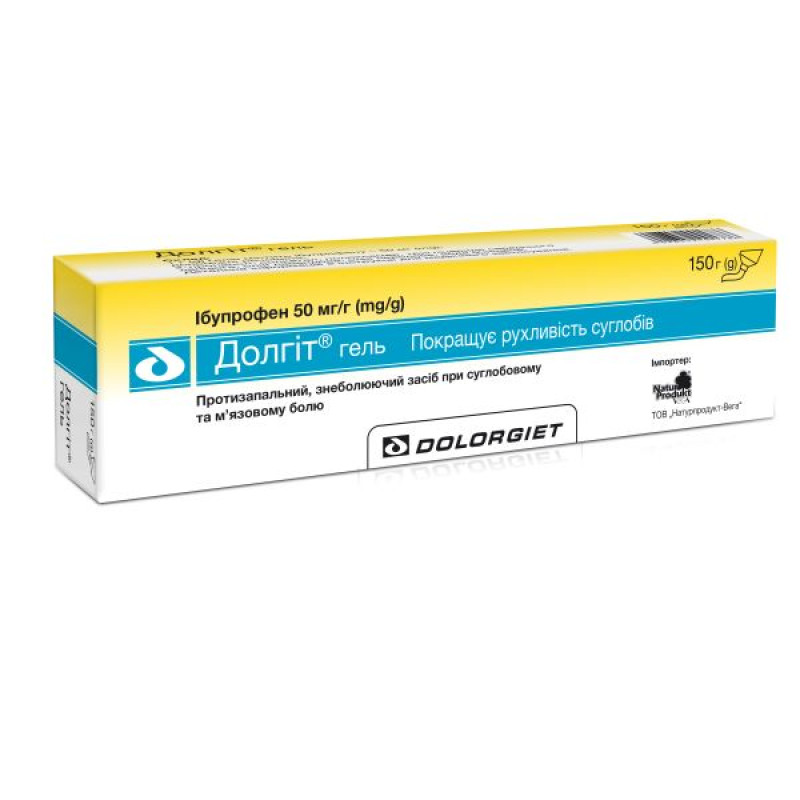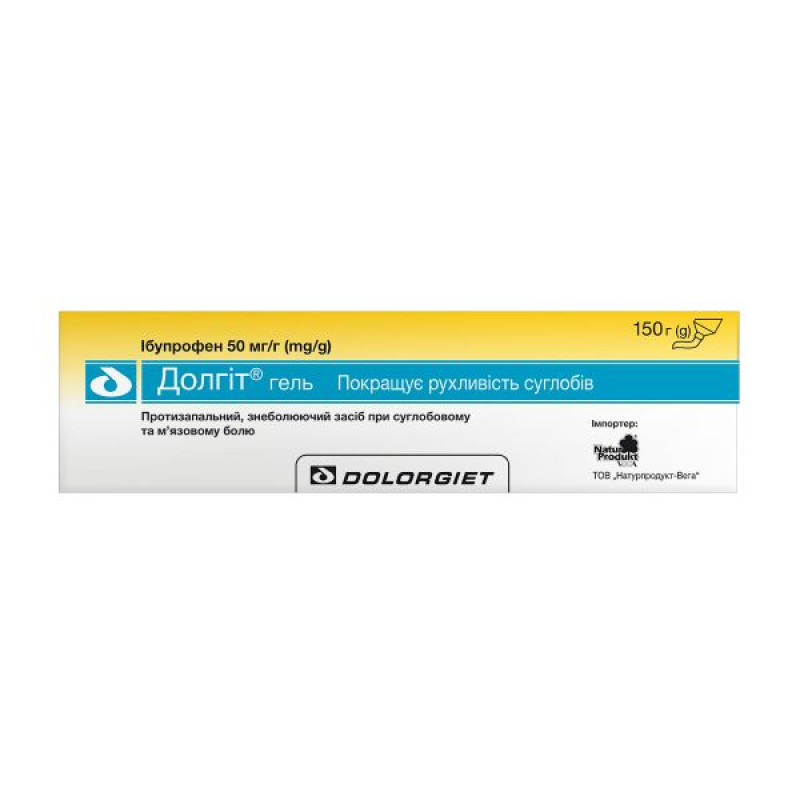Dolgit gel tube 150 g

Instructions Dolgit gel tube 150 g
Composition
active ingredient: ibuprofen;
1 g of gel contains ibuprofen 50 mg;
excipients: 2-propanol, solketal, poloxamer, medium chain triglycerides, lavender oil, neroli oil, purified water.
Dosage form
Gel.
Main physicochemical properties: transparent, colorless or slightly cloudy, with a characteristic gel odor.
Pharmacotherapeutic group
Topical agents for joint and muscle pain. ATX code M02A A13.
Pharmacological properties
Pharmacodynamics.
"Dolgit® gel" is a drug for topical use in joint and muscle pain of rheumatic and non-rheumatic origin. It has a pronounced anti-inflammatory, analgesic and moderate antipyretic effect, reduces swelling that occurs with inflammation caused by injuries or rheumatic diseases, improves joint mobility. The pharmacological activity of the drug is due to its ability to inhibit the synthesis of prostaglandins.
When applied topically, ibuprofen is rapidly absorbed through the skin and penetrates into the focus of inflammation. Penetration to the site of action may vary depending on the degree and type of lesion, as well as the site of application and the site of action.
In joint tissues, therapeutic concentrations are maintained for several hours, while in blood serum the active substance is present in only a small amount, so systemic action is practically absent.
Pharmacokinetics.
Biological transformation of ibuprofen occurs in the liver. Pharmacologically inactive metabolites are eliminated by the kidneys (90%) and with bile. Ibuprofen is 99% bound to plasma proteins. The half-life is 1.8–3.5 hours.
Indication
For local treatment of sports and other injuries, such as muscle strain, sprain, tendon or bruise, degenerative joint diseases with pain syndrome (arthrosis), inflammatory rheumatic diseases of the joints and spine, swelling or inflammation of soft tissues near the joints (e.g., bursitis, tendonitis, tendovaginitis, damage to ligaments and joint capsule), stiffness of movements in the shoulder area, lower back pain, lumbago, myalgia.
Contraindication
"Dolgit® gel" is contraindicated:
- with increased individual sensitivity to the active substance ibuprofen, benzyl alcohol, benzyl benzoate, citral, citronellol, coumarin, eugenol, farnesol, geraniol, limonene/d-limonene, linalool, to any of the excipients of the medicinal product or to other analgesics and antirheumatic drugs (non-steroidal anti-inflammatory drugs);
- for use on open wounds, for inflammatory and infectious skin diseases such as eczema, as well as for use on mucous membranes;
- for use under an occlusive dressing;
- in the last trimester of pregnancy.
Interaction with other medicinal products and other types of interactions
When the drug is used externally according to the recommendations, no interactions with other drugs were observed.
It is necessary to inform the doctor about simultaneous treatment with other medications, if this occurs, or about recent therapy.
Application features
Patients with asthma, hay fever, swelling of the nasal mucosa (so-called rhinopolyps), chronic obstructive airway diseases or chronic respiratory infections (especially with symptoms resembling hay fever) and patients with hypersensitivity to analgesics and antirheumatic drugs of various types are at increased risk of developing asthma attacks (so-called analgesic intolerance/analgesic asthma), local swelling of the skin and mucous membranes (Quincke's edema) or urticaria. The use of the drug in such patients should be carried out under the supervision of a physician.
The drug should be used with caution in patients with hypersensitivity (allergy) to other substances that cause skin irritation, itching, or hives.
If a skin rash appears, stop using the gel immediately.
Do not allow the drug to get into the eyes.
Care should be taken to ensure that children do not touch the treated areas of skin. Hands should be washed thoroughly after each application of the product, unless they are the object of treatment.
If discomfort during treatment lasts longer than 3 days, you should consult a doctor.
Due to the possible occurrence of excessive photosensitivity, patients should avoid intense exposure to sunlight/UV rays while using the drug.
This medicine contains fragrances (lavender oil and neroli oil) with benzyl alcohol, benzyl benzoate, citral, citronellol, coumarin, eugenol, farnesol, geraniol, limonene/d-limonene, linalool, which may cause allergic reactions.
Use during pregnancy or breastfeeding
There is insufficient data to assess the safety of ibuprofen during pregnancy.
The drug is contraindicated in the last trimester of pregnancy. Due to the inhibition of labor, there is a risk of prolongation of pregnancy and delayed labor, the occurrence of cardiovascular problems (premature closure of the ductus arteriosus, pulmonary hypertension) and renal toxicity (oliguria, oligohydramnios) in the fetus, an increased likelihood of bleeding in the mother and child, and an increased risk of edema in the mother.
Only a small amount of active ibuprofen derivatives and its breakdown products pass into breast milk. At the moment there is no data on the negative effect on the newborn, therefore in the case of short-term treatment there is no need to interrupt breastfeeding. However, the daily dose with three applications of a gel strip 4–10 cm long should not be exceeded, and in the case of long-term treatment it is necessary to interrupt breastfeeding.
Breastfeeding women should not apply this medicine to the breast area to avoid the medicine getting into the baby's body.
Ability to influence reaction speed when driving vehicles or other mechanisms
The drug does not affect the ability to drive vehicles and work with potentially dangerous mechanisms.
Method of administration and doses
For external use only. Apply the medicine 3–4 times a day.
Depending on the size of the affected area, apply a thin layer of the gel to the skin in the area of inflammation/pain in strips 4–10 cm long (corresponding to 2–5 g of gel, or 100–250 mg of ibuprofen) followed by gentle rubbing until completely absorbed. The maximum daily dose is 20 g of gel (corresponding to 1,000 mg of ibuprofen).
The duration of treatment is determined by the doctor. In most cases, the duration of treatment is 1–2 weeks. There is no data on the therapeutic benefit of using the drug for a longer period.
Do not use under an occlusive dressing.
The penetration of the active ingredient can be enhanced by iontophoresis (a special form of electrotherapy). In this case, the drug is applied under the cathode (negative electrode), the current intensity is 0.1–0.5 mA per 5 cm2 of the electrode surface, the duration of the procedure is up to 10 minutes.
Children.
Do not use in children under 14 years of age.
Overdose
If more gel than recommended is applied, remove the remaining gel and rinse the skin with water. If a very large amount is applied or if the gel is accidentally taken internally, a doctor should be informed. There is no specific antidote known.
Side effects
Classification of adverse reactions by frequency of occurrence: very common (≥ 1/10), common (≥ 1/100, < 1/10), uncommon (≥ 1/1,000, < 1/100), isolated (≥ 1/10,000, < 1/1,000), rare (< 1/10,000), frequency unknown.
Common: local reactions such as skin redness, itching, burning sensation, exanthema, including pustules and blisters; uncommon: hypersensitivity reactions such as local allergic reactions (contact dermatitis); rare: bronchospastic reactions; frequency unknown: photosensitivity reactions.
When using the drug "Dolgit® gel" on large areas of skin and for a long time, adverse reactions that affect certain organs or the body as a whole and are possible with the systemic use of drugs containing ibuprofen cannot be excluded.
Benzyl alcohol, benzyl benzoate, citral, citronellol, coumarin, eugenol, farnesol, geraniol, limonene/d-limonene, linalool may cause allergic reactions.
Expiration date
30 months.
Storage conditions
Store in the original packaging at a temperature not exceeding 25 °C.
Keep out of reach of children.
Packaging
20 g or 50 g or 100 g in a tube; 1 tube in a cardboard box.
Vacation category
Without a prescription.
Producer
Dolorgiet GmbH & Co. KG.
Address.
Otto von Guericke Str. 1, 53757 St. Augustin, Germany/
Otto-von-Gueriske-Str. 1, 53757 Sankt Augustin, Germany.
There are no reviews for this product.
There are no reviews for this product, be the first to leave your review.
No questions about this product, be the first and ask your question.



